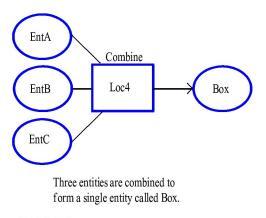
You are here: Building the Model: Advanced Elements > Attributes > Attributes and the COMBINE Statement
Consider the example where several entities are combined permanently into a single entity, Box. See Combine for more information. The combined entity, Box, assumes the attribute values of the last entity that was combined to the single entity. If three entities, EntA, EntB, and EntC, are combined to form a single entity called Box, and EntC was the last entity that was combined, the Box will have the same attribute values as EntC. Therefore, if EntC had an attribute (Att1=5), then Att1=5 for the combined entity, Box. The following diagram demonstrates three entities combining into one entity.

The logic for the diagram is as follows:
Process Table
|
Entity |
Location |
Operation (min) |
|---|---|---|
|
EntA |
Loc1 |
Att1 = 1 WAIT 2 min |
|
EntB |
Loc2 |
Att1 = 3 WAIT 3 min |
|
EntC |
Loc3 |
Att1 = 5 WAIT 6 |
|
ALL |
Loc4 |
COMBINE 3 |
|
ALL |
Loc5 |
... |
Routing Table
|
Blk |
Output |
Destination |
Rule |
Move Logic |
|---|---|---|---|---|
|
1 |
EntA |
Loc4 |
FIRST 1 |
MOVE FOR 1 |
|
1 |
EntB |
Loc4 |
FIRST 1 |
MOVE FOR 3 |
|
1 |
EntC |
Loc4 |
FIRST 1 |
MOVE FOR .5 |
|
1 |
Box |
Loc5 |
FIRST 1 |
MOVE FOR 1 |
|
... |
... |
... |
... |
... |
In the above example, EntC is the last entity to be combined so the entity Box assumes the attribute value of EntC, Att1=5.